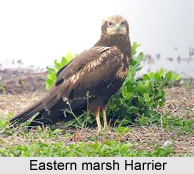 Eastern Marsh Harrier is an Indian bird with a scientific name "Circus spilonotus" is a bird of prey belonging to the marsh harrier group of harriers. It was previously considered to be con-specific with the western marsh harrier but is now usually classified as a separate species.
Eastern Marsh Harrier is an Indian bird with a scientific name "Circus spilonotus" is a bird of prey belonging to the marsh harrier group of harriers. It was previously considered to be con-specific with the western marsh harrier but is now usually classified as a separate species.
Categories of Eastern Marsh Harrier
Eastern Marsh Harrier has two subspecies: C. S. spilonotus in eastern Asia and C. S. spilothorax in New Guinea.
Structure of Eastern Marsh Harrier
Eastern marsh harrier is 48 to 58 cm long with a wingspan of 113 to 137 cm; like most birds of prey, the female is usually larger than the male. The male`s plumage is variable; typically the head, breast, back and wing-coverts are blackish with pale streaks. The rest of the wing is grey with black wingtips and a white front edge. The tail is grey, the rump is white and the under parts are mostly white. The female is dark brown with buff streaking on the head and under parts. The rump is often whitish and the tail has dark bars. Young birds are dark brown with buff on the head and a pale patch on the under wing.
Character Trait of Eastern Marsh Harrier
Eastern Marsh Harrier is usually silent but has a mewing call which is most often uttered at roost sites.
Migration of Eastern Marsh Harrier
Eastern Marsh Harriers are generally migratory apart from the Papuan harrier which is sedentary. The breeding range of Eastern marsh harrier covers north-east China, Mongolia and south-east Siberia (as far west as Lake Baikal) with small numbers in northern Japan. There is some overlap with western marsh harrier around Lake Baikal and interbreeding has taken place. The wintering range includes southern China, Taiwan, Korea, southern Japan, north-east Indian states like Assam, Nagaland, Mizoram, Tripura and Meghalaya and some parts of Arunachal Pradesh, Bangladesh and South-east Asia as far south as the Philippines, Borneo and Sumatra. Large numbers of birds migrate along the Chinese coast with thousands passing through sites like Beidaihe during the autumn.
Concentration of Eastern Marsh Harrier
Eastern Marsh Harrier is preferred habitat and is an open country including marshland, paddy fields and grassland.
Prey of Eastern Marsh Harrier
While hunting Eastern Marsh Harrier flies low over the ground with the wings held in a shallow V-shape. The prey of Eastern marsh harrier includes small mammals, birds and frogs.
Breeding Season of Eastern Marsh Harrier
The breeding season of Eastern Marsh Harrier begins in April. The nest of Eastern marsh harrier is made of sticks and built on the ground, usually in a reedbed. The four to seven eggs of Eastern marsh harrier are laid which are incubated for 33 to 48 days. The young Eastern Marsh Harriers fledge after 35 to 40 days.











